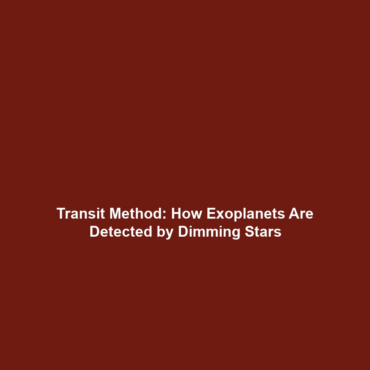The Transit Method in Exoplanet Detection
Exoplanets, or planets beyond our solar system, have captivated astronomers and scientists, driving a quest for knowledge regarding these distant worlds. One of the most significant techniques employed to detect exoplanets is the transit method, which identifies how exoplanets are detected when they pass in front of their host star, causing a temporary dimming of the star’s light. This revolutionary methodology has enhanced our understanding of planetary systems and transformed the landscape of astronomy and planetary science.
Key Concepts
The transit method relies on the principle of observing light curves, which graph the brightness of a star over time. When an exoplanet transits, or passes in front of its star, it blocks a fraction of the star’s light, leading to a detectable dip in brightness. The following concepts are critical to understanding this detection technique:
- Light Curves: The plotting of brightness versus time allows astronomers to identify transits.
- Transit Depth: The amount of dimming is proportional to the size of the exoplanet relative to the star.
- Orbital Period: The time between successive transits helps determine the distance of the exoplanet from its star, using Kepler’s laws of planetary motion.
Overall, the transit method plays a pivotal role within the broader context of exoplanet research, yielding insights into the composition, atmospheres, and potential habitability of these distant worlds.
Applications and Real-World Uses
The transit method is widely used in exoplanetary research and has several significant applications:
- Detection of Exoplanets: The primary application is discovering new exoplanets; missions such as NASA’s Kepler Space Telescope have confirmed thousands of new worlds using this method.
- Characterization of Exoplanets: By analyzing transit data, researchers can infer the size and orbital properties of exoplanets.
- Study of Exoplanet Atmospheres: The transit method allows scientists to examine the chemical composition of exoplanet atmospheres by studying the starlight filtering through them.
These real-world applications illustrate how the transit method is instrumental in advancing our understanding of exoplanets and the potential for life beyond Earth.
Current Challenges
Despite its successes, there are challenges associated with the transit method that impact its effectiveness. These include:
- False Positives: Variability in stars can mimic transit signatures, leading to incorrect detections.
- Limited Visibility: Not all exoplanets transit their stars from our viewpoint, limiting discovery potential.
- Impact of Stellar Activity: Stellar flares and other activities can obscure or distort transit signals.
Addressing these challenges is crucial for improving the accuracy and efficiency of the transit method in exoplanet detection.
Future Research and Innovations
Looking ahead, ongoing research and technological innovations hold promise for enhancing the transit method. Significant developments include:
- Next-Generation Telescopes: Missions like the James Webb Space Telescope (JWST) are expected to provide unprecedented detail on exoplanet atmospheres.
- Machine Learning Techniques: The use of artificial intelligence to analyze light curves could improve detection rates and reduce false positives.
- Enhanced Ground-Based Observatories: Ongoing advancements in ground observatory technologies will allow for better confirmation of transit candidates.
These innovations are anticipated to revolutionize the study of exoplanets, offering hope for future discoveries and deeper insights.
Conclusion
The transit method is crucial for the detection of exoplanets, enabling astronomers to gain insights into distant planetary systems. As we navigate the existing challenges and embrace emerging technologies, the potential for new discoveries continues to expand. For more information on exoplanets and exploration techniques, visit our Exoplanets Overview and learn how these distant worlds impact our understanding of the universe.

Leave a Reply